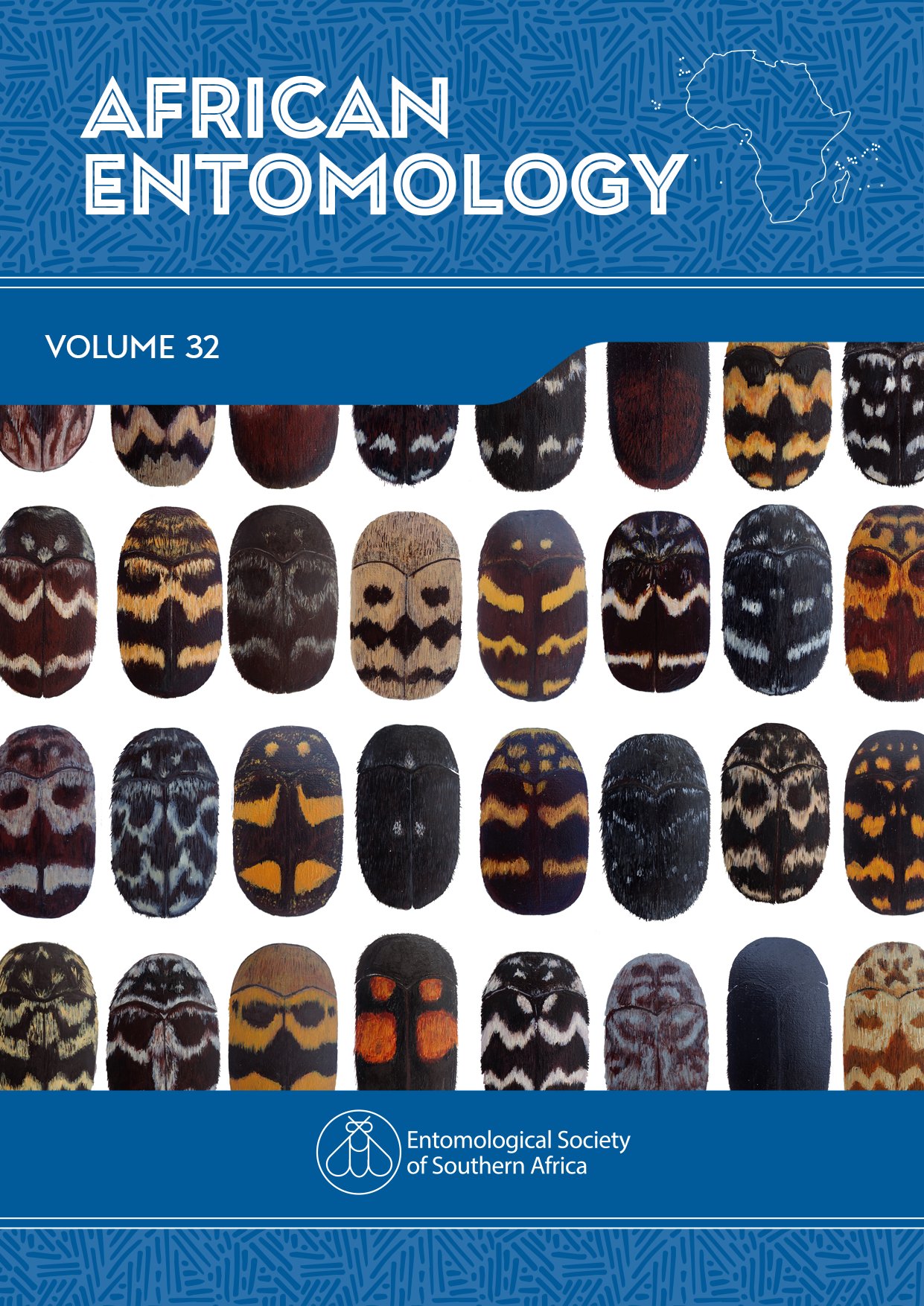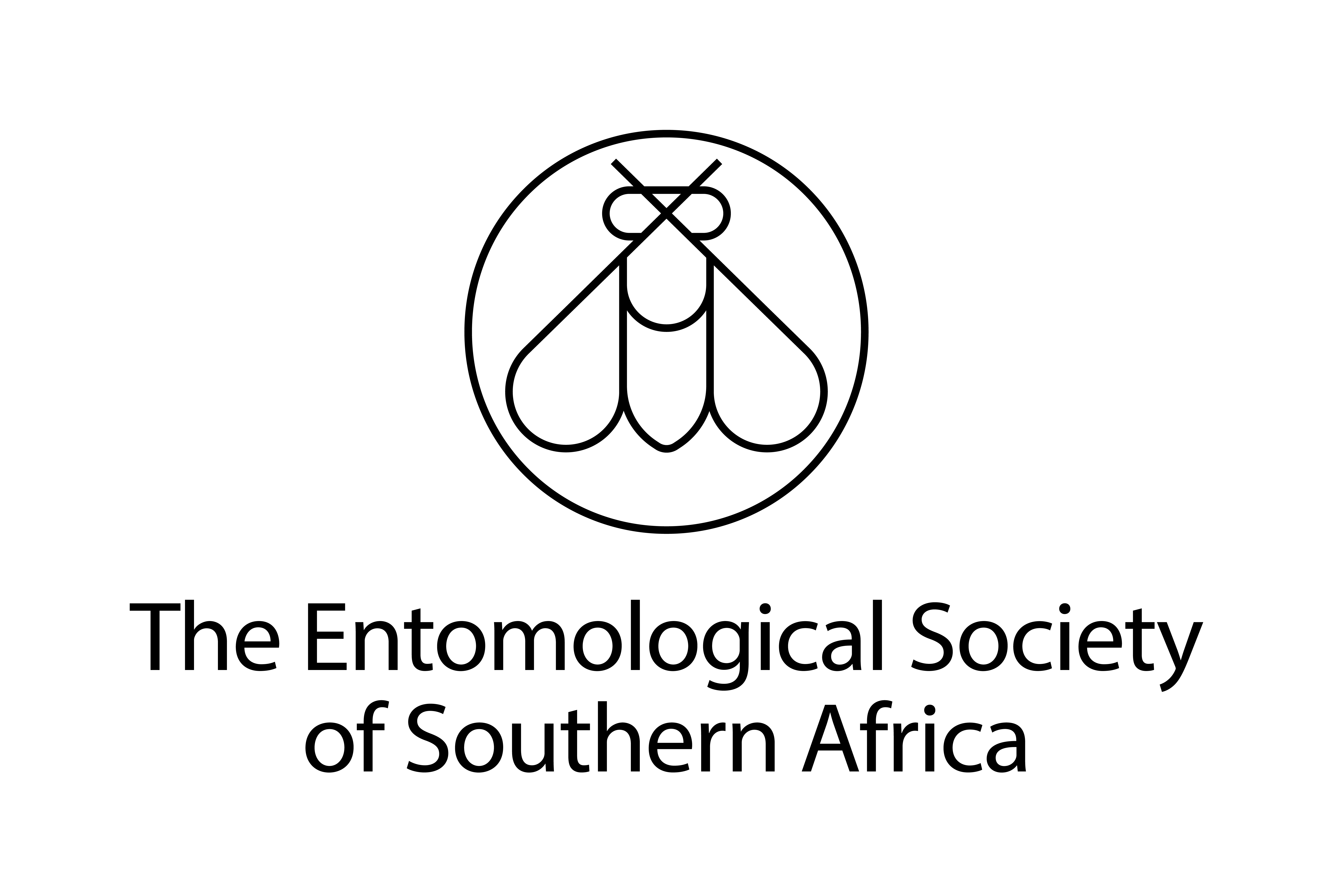The effect of mixed honeybee drone semen on sperm quality characteristics: A preliminary study
DOI:
https://doi.org/10.17159/2254-8854/2024/a17135Keywords:
drone, sperm, functionality, motility, kinematics, concentrationAbstract
Following copulation, sperm of multiple honeybee (Apis mellifera (A.m.) Linnaeus (Apidae)) drones are mixed inside the spermatheca of a queen, and sperm behaviour in this environment is of importance for sperm survival and successful fertilization. The polyandrous mating system of honeybees further may allow for cryptic female choice and sperm competition to select for specific sperm traits to enable successful reproduction. This preliminary study therefore examined multiple sperm quality parameters in mixed drone semen. Thirty-one drone ejaculates were collected and split to be mixed with one and two other drones’ semen. A computerised sperm analysis system was used for analysing sperm functionality parameters, at baseline and 60 minutes. Morphology measurements included head, tail, and total sperm length. Sperm concentration was significantly higher in three-drone samples compared to other groups (p < 0.001), while comparisons of sperm functional and morphometric parameters did not reveal differences. However, after 60 minutes, mixed semen samples displayed changes in terms of sperm functionality. The motility percentage significantly decreased in two-drone samples (p = 0.004). In contrast, three-drone samples had consistently lower motility and kinematic parameters at baseline, but following an hour it was the only group to show improvement in sperm progressive motility, swimming speed and kinematics. Sperm concentration correlated with the majority of functionality parameters, while, morphological measurements did not. Sperm functionality changes observed in this study, can be attributed to a combination of factors, including, mixing of drone semen, sperm concentration, and time allowing for potential sperm interaction.
Downloads
References
Abdelkader FB, Barbouche N, Belzunces L, Brunet JL. 2015. Effects of some insecticides on the viability and the ATP synthesis of honeybee drone’s spermatozoid in vitro exposed. Tunisian Journal of Plant Protection. 10:79–93.
Abderkader FB, Kairo G, Tchamitchian S, Bonnet M, Cousin M, Barbouche N, Belzunces LP, Brunet J. 2018. Effects of Clothianidin exposure on semen parameters of honey bee drones. Journal of New Sciences, Agriculture and Biotechnology. 59:3791–3798.
Al-Lawati H, Kamp G, Bienefeld K. 2009. Characteristics of the spermathecal contents of old and young honeybee queens. Journal of Insect Physiology. 55:117–122. https://doi.org/10.1016/j.jinsphys.2008.10.010.
Baer B, de Jong G, Schmid-Hempel R, Schmid-Hempel P, Høeg JT, Boomsma JJ. 2006. Heritability of sperm length in the bumblebee Bombus terrestris. Genetica. 127(1-3):11–23. https://doi.org/10.1007/s10709-005-2157-1.
Baer B, Eubel H, Taylor NL, O’Toole N, Millar AH. 2009. Insights into female sperm storage from the spermathecal fluid proteome of the honeybee Apis mellifera. Genome Biology. 10(6):R67. https://doi.org/10.1186/gb-2009-10-6-r67.
Baer B. 2003. Bumblebees as model organisms to study male sexual selection in social insects. Behavioral Ecology and Sociobiology. 54(6):521–533. https://doi.org/10.1007/s00265-003-0673-5.
Baer B. 2005. Sexual selection in Apis bees. Apidologie (Celle). 36(2):187–200. https://doi.org/10.1051/apido:2005013.
Ben Abdelkader F, Kairo G, Tchamitchian S, Cousin M, Senechal J, Crauser D, Vermandere JP, Alaux C, Le Conte Y, Belzunces LP, et al. 2014. Semen quality of honey bee drones maintained from emergence to sexual maturity under laboratory, semi-field and field conditions. Apidologie (Celle). 45(2):215–223. https://doi.org/10.1007/s13592-013-0240-7.
Borsuk G, Kozłowska M, Anusiewicz M, Olszewski K. 2018. A scientific note on DNA fragmentation rates in sperm collected from drones and spermathecae of queens of different age, with possible implications on the scattered brood phenomenon. Apidologie (Celle). 49(6):803–806. https://doi.org/10.1007/s13592-018-0603-1.
Borsuk G, Olszewski K, Strachecka A, Paleolog J, Gagoś M. 2011. Microscopic image of honeybee drone spermatozoa in three diluents. Journal of Apicultural Science. 55:73–80.
Bratu IC, Igna V, Simiz E, Dunea IB, Pătruică S. 2022. The influence of body weight on semen parameters in Apis mellifera drones. Insects. 13(12):1141. https://doi.org/10.3390/insects13121141.
Brutscher LM, Baer B, Niño EL. 2019. Putative drone copulation factors regulating honey bee (Apis mellifera) queen reproduction and health: A review. Insects. 10:8. https://doi.org/10.3390/insects10010008.
Buys B. 1990. Features of basic reproduction in drones and queens of the Cape honeybee Apis mellifera capensis. In: Anderson RH, Buys B (editors), Proceedings of the International Beekeepers’ Symposium: Bees and Beekeeping in Southern Africa: Posa & WPBA. p. 106–109.
Cobey SW, Tarpy DR, Woyke J. 2013. Standard methods for instrumental insemination of Apis mellifera queens. Journal of Apicultural Research. 52(4):1–18. https://doi.org/10.3896/IBRA.1.52.4.09.
Collins AM, Caperna TJ, Williams V, Garrett WM, Evans JD. 2006. Proteomic analyses of male contributions to honey bee sperm storage and mating. Insect Molecular Biology. 15(5):541–549. https://doi.org/10.1111/j.1365-2583.2006.00674.x.
Collins AM. 2000. Relationship between semen quality and performance of instrumentally inseminated honey bee queens. Apidologie (Celle). 31(3):421–429. https://doi.org/10.1051/apido:2000132.
Collins AM. 2003. A scientific note on the effect of centrifugation on pooled honey bee semen. Apidologie (Celle). 34(5):469–470. https://doi.org/10.1051/apido:2003030.
Collins AM. 2004. Sources of variation in the viability of honey bee, Apis mellifera L., semen collected for artificial insemination. Invertebrate Reproduction and Development. 45(3):231–237. https://doi.org/10.1080/07924259.2004.9652594.
Curtis SK, Benner DB. 1991. Movement of spermatozoa of Megaselia scalaris (Diptera:Brachycera:Cyclorrhapha:Phoridae) in artificial and natural fluids. Journal of Morphology. 210(1):85–99. https://doi.org/10.1002/jmor.1052100108.
Delaplane KS, Given JK, Menz J, Delaney DA. 2021. Colony fitness increases in the honey bee at queen mating frequencies higher than genetic diversity asymptote. Behavioral Ecology and Sociobiology. 75(9):126–137. https://doi.org/10.1007/s00265-021-03065-6.
den Boer SPA, Baer B, Boomsma JJ. 2010. Seminal fluid mediates ejaculate competition in social insects. Science. 327(5972):1506–1509. https://doi.org/10.1126/science.1184709.
Eckel BA, Guo R, Reinhardt K. 2017. More pitfalls with sperm viability staining and a viability-based stress test to characterize sperm quality. Frontiers in Ecology and Evolution. 5:165. https://doi.org/10.3389/fevo.2017.00165.
Fitzpatrick JL, Lüpold S. 2014. Sexual selection and the evolution of sperm quality. Molecular Human Reproduction. 20(12):1180–1189. https://doi.org/10.1093/molehr/gau067.
Gençer HV, Kahya Y, Woyke J. 2014. Why the viability of spermatozoa diminishes in the honeybee (Apis mellifera) within short time during natural mating and preparation for instrumental insemination. Apidologie (Celle). 45(6):757–770. https://doi.org/10.1007/s13592-014-0295-0.
Gençer HV, Kahya Y. 2011. The viability of sperm in lateral oviducts and spermathecae of instrumentally inseminated and naturally mated honey bee (Apis mellifera L.) queens. Journal of Apicultural Research. 50(3):190–194. https://doi.org/10.3896/IBRA.1.50.3.02.
Gençer HV, Kahya Y. 2020. Sperm competition in honey bees (Apis mellifera L.): the role of body size dimorphism in drones. Apidologie (Celle). 51(1):1–17. https://doi.org/10.1007/s13592-019-00699-4.
Gontarz A, Banaszewska D, Gryzinska M, Andraszek K. 2016. Differences in drone sperm morphometry and activity at the beginning and end of the season. Turkish Journal of Veterinary and Animal Sciences. 40:598–602. https://doi.org/10.3906/vet-1511-6.
Harbo JR. 1990. Artificial mixing of spermatozoa from honeybees and evidence for sperm competition. Journal of Apicultural Research. 29(3):151–158. https://doi.org/10.1080/00218839.1990.11101212.
Hook KA, Fisher HS. 2020. Methodological considerations for examining the relationship between sperm morphology and motility. Molecular Reproduction and Development. 87(6):633–649. https://doi.org/10.1002/mrd.23346.
Inouri-Iskounen A, Sadeddine-Zennouche O, Nait Mouloud M, Kebieche M, Iguer-Ouada M. 2020. In vitro effects of imidacloprid on honey bee sperm: evaluation using computer-aided sperm analysis (CASA). Journal of Apicultural Research. 59(4):343–349. https://doi.org/10.1080/00218839.2020.1775017.
Kraus FB, Neumann P, van Praagh J, Moritz RFA. 2004. Sperm limitation and the evolution of extreme polyandry in honeybees (Apis mellifera L). Behavioral Ecology and Sociobiology. 55(5):494–501. https://doi.org/10.1007/s00265-003-0706-0.
Lee PE, Wilkes A. 1965. Polymorphic spermatozoa in the hymenopterous wasp Dahlbominus. Science. 147(3664):1445–1446. https://www.jstor.org/stable/1715045. https://doi.org/10.1126/science.147.3664.1445.
Liberti J, Baer B, Boomsma JJ. 2018. Rival seminal fluid induces enhanced sperm motility in a polyandrous ant. BMC Evolutionary Biology. 18(1):28. https://doi.org/10.1186/s12862-018-1144-y.
Liu Z, Liu F, Li G, Chi X, Wang Y, Wang H, Ma L, Han K, Zhao G, Guo X, et al. 2020. Metabolite support of long-term storage of sperm in the spermatheca of honeybee (Apis mellifera) queens. Frontiers in Physiology. 11:574856. https://doi.org/10.3389/fphys.2020.574856.
Lodesani M, Balduzzi D, Galli A. 2004. Functional characterisation of semen in honeybee queen (A.m. ligustica S.) spermatheca and efficiency of the diluted semen technique in instrumental insemination. Italian Journal of Animal Science. 3(4):385–392. https://doi.org/10.4081/ijas.2004.385.
Lodesani M, Balduzzi D, Galli A. 2004. A study on spermatozoa viability over time in honey bee (Apis mellifera ligustica) queen spermathecae. Journal of Apicultural Research. 43(1):27–28. https://doi.org/10.1080/00218839.2004.11101105.
Lu JC, Huang YF, Lü NQ. 2014. Computer-aided sperm analysis: past, present and future. Andrologia. 46(4):329–338. https://doi.org/10.1111/and.12093.
Lüpold S, Manier MK, Berben KS, Smith KJ, Daley BD, Buckley SH, Belote JM, Pitnick S. 2012. How multivariate ejaculate traits determine competitive fertilization success in Drosophila melanogaster. Current Biology. 22(18):1667–1672. https://doi.org/10.1016/j.cub.2012.06.059.
Mattila HR, Seeley TD. 2007. Genetic diversity in honey bee colonies enhances productivity and fitness. Science. 317(5836):362–364. https://doi.org/10.1126/science.1143046.
Morais LS, Araujo Neto ERA, Silva AM, Marinho DEL, Bezerra LGP, Velarde JMDS, Silva AR, Gramacho KP, Message D. 2022. Sperm characteristics of Africanized honey bee (Apis mellifera L.) drones during dry and wet seasons in the Caatinga biome. Journal of Apicultural Research. https://doi.org/10.1080/00218839.2022.2113328.
Moritz RFA. 1986. Intracolonial worker relationship and sperm competition in the honeybee (Apis mellifera L.). Experientia. 42(4):445–448. https://doi.org/10.1007/BF02118652.
Mortimer D, Mortimer ST, Horst G. 2015. The future of computeraided sperm analysis. Asian Journal of Andrology. 17(4):545–553.
https://doi.org/10.4103/1008-682X.154312.
Murray JF, van der Horst G, Allsopp M, Kotzé RCM. 2023. A new fluorescent method to determine honey bee sperm motility parameters with computer-aided sperm analysis. Journal of Apicultural Research. 62(4):944–952. https://doi.org/10.1080/00218839.2022.2090729.
Özkök AO, Selçuk M. 2020. Sperm storage and artificial insemination in honey bees (Apis mellifera L.). International Journal of Science Letters. 2(1):12–25. https://doi.org/10.38058/ijsl.661629.
Pearcy M, Delescaille N, Lybaert P, Aron S. 2014. Team swimming in ant spermatozoa. Biology Letters. 10(6):20140308. https://doi.org/10.1098/rsbl.2014.0308.
Pizzari T, Foster KR. 2008. Sperm sociality: cooperation, altruism, and spite. PLoS Biology. 6(5):e130. https://doi.org/10.1371/journal.pbio.0060130.
Rangel J, Fisher A 2nd. 2019. Factors affecting the reproductive health of honey bee (Apis mellifera) drones—a review. Apidologie (Celle). 50(6):759–778. https://doi.org/10.1007/s13592-019-00684-x.
Reinhardt K. 2007. Evolutionary consequences of sperm cell aging. The Quarterly Review of Biology. 82(4):375–393. https://doi.org/10.1086/522811.
Rinderer TE, de Guzman LI, Lancaster VA, Delatte GT, Stelzer JA. 1999. Varroa in the mating yard: 1. The effects of Varroa jacobsoni and Apistan® on drone honey bees. American Bee Journal 139(2):134–139.
Schlüns H, Schlüns EA, Van Praagh J, Moritz RF. 2003. Sperm numbers in drone honeybees (Apis mellifera) depend on body size. Apidologie (Celle). 34(6):577–584. https://doi.org/10.1051/apido:2003051.
Shafir S, Kabanoff L, Duncan M, Oldroyd BP. 2009. Honey bee (Apis mellifera) sperm competition in vitro — two are no less viable than one. Apidologie (Celle). 40(5):556–561. https://doi.org/10.1051/apido/2009014.
Strobl V, Straub L, Bruckner S, Albrecht M, Maitip J, Kolari E, Chantawannakul P, Williams GR, Neumann P. 2019. Not every sperm counts: male fertility in solitary bees, Osmia cornuta. PLoS One. 14(3):e0214597. https://doi.org/10.1371/journal.pone.0214597.
Stürup M, Baer-Imhoof B, Nash DR, Boomsma J, Baer B. 2013. When every sperm counts: factors affecting male fertility in the honeybee Apis mellifera. Behavioral Ecology. 24(5):1192–1198. https://doi.org/10.1093/beheco/art049.
Swart DJ. 2001. General Management. In: Johannsmeier MF (editor), Beekeeping in South Africa, Plant Protection Handbook No 14. 3rd ed. Pretoria: Agricultural Research Council. pp. 74–84.
Tarpy DR, Olivarez R Jr. 2014. Measuring sperm viability over time in honey bee queens to determine patterns in stored-sperm and queen longevity. Journal of Apicultural Research. 53(4):493–495. https://doi.org/10.3896/IBRA.1.53.4.02.
Tofilski A, Chuda-Mickiewicz B, Czekońska K, Chorbiński P. 2012. Flow cytometry evidence about sperm competition in honey bee (Apis mellifera). Apidologie (Celle). 43(1):63–70. https://doi.org/10.1007/s13592-011-0089-6.
Tofilski A, Chuda-Mickiewicz B, Czekońska K. 2018. Circular movement of honey bee spermatozoa inside spermatheca. Invertebrate Reproduction and Development. 62(2):63–66. https://doi.org/10.1080/07924259.2018.1445042.
Verma LR. 1973. An ionic basis for a possible mechanism of sperm survival in the spermatheca of the queen honey bee (Apis mellifera L.). Comparative Biochemistry and Physiology A . 44(4):1325–1331. https://doi.org/10.1016/0300-9629(73)90272-7.
Wegener J, May T, Kamp G, Bienefeld K. 2014. A successful new approach to honeybee semen cryopreservation. Cryobiology. 69(2):236–242. https://doi.org/10.1016/j.cryobiol.2014.07.011.
Withrow JM, Tarpy DR. 2018. Cryptic royal subfamilies in honey bee (Apis mellifera) colonies. PLoS One. 13(7):e0199124. https://doi.org/10.1371/journal.pone.0199124.
World health organization (WHO). 2021. WHO laboratory manual for the examination and processing of human semen. 6th edition. Geneva. https://www.who.int/publications/i/item/9789240030787.
Woyciechowski M, Król E. 1996. On intraoviductal sperm competition in the honeybee (Apis mellifera). Folia Biologica. 44:51–53.
Yániz J, Palacín I, Santolaria P. 2019. Effect of chamber characteristics, incubation, and diluent on motility of honey bee (Apis mellifera) drone sperm. Apidologie (Celle). 50(4):472–481. https://doi.org/10.1007/s13592-019-00659-y.
Yániz JL, Silvestre MA, Santolaria P. 2020. Sperm quality assessment in honey bee drones. Biology (Basel). 9(7):174. https://doi.org/10.3390/biology9070174.
Downloads
Additional Files
Published
Issue
Section
License
Copyright (c) 2024 Retha Kotze, Gerhard van der Horst, Janice F Murray, Anja Duminy, Mike Allsopp

This work is licensed under a Creative Commons Attribution 4.0 International License.
How to Cite
Funding data
-
National Research Foundation
Grant numbers 138168




.png)